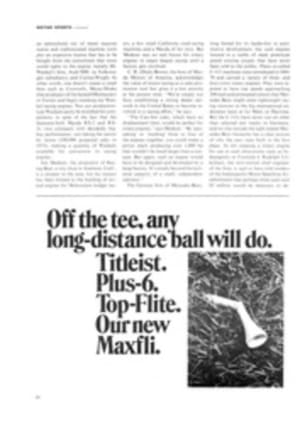
The new little engine that couldn't
Call it anything you want: a Wankel, a rotary, a rotating combustion engine or simply an R.C., but the trendy types in the automobile business will tell you that this tiny package is the power plant of tomorrow. They are probably right. Because of its outsized ratio of power to size, the Wankel's future seems bright, especially in the face of increasing government regulations concerning exhaust emissions. The new engine's vest-pocket dimensions permit manufacturers to bolt on all sorts of plumbing to purify the exhaust while keeping the basic unit small, light, uncomplicated and reasonably priced. Now that General Motors has given the Wankel its seal of approval by indicating that some versions of its Vega subcompact will be sold with rotary engines as early as Spring 1974, there is little question that automobiles of every size and nationality will be humming along under "R.C. Power" by the end of the decade.
Well then, if the Wankel is so much in the vanguard of automotive engineering, there must be fleets of rotary-powered racing cars being readied for competition. Surely, half the Grand Prix and Indianapolis cars will be propelled by Wankels in a few years. After all, the doyens of the sport like to describe themselves as being in the vanguard of automotive technology, and it stands to reason that if the Wankel is in fact a device to "improve the breed," the racers will soon have it on the tracks.
That is not the case. For 1973 at least, the Eagles, the McLarens, Ferraris, BRMs, Lolas, Porsches, etc. must make do with old-fashioned, embarrassingly conventional reciprocating engines thumping away in their innards. It is not that the racers shun the Wankel, but their problem is twofold: first, present regulations governing the displacement classification remove much of the new engine's advantages, and, second, it would be astronomically expensive to develop a racing Wankel without the aid of an automobile manufacturer.
Because the Wankel is such a departure from normal automotive engines, an ongoing argument has developed over how to determine its displacement or "size," and as long as the dispute is unresolved, few people will experiment with the power plant in big-time competition. Establishing the size of a normal reciprocating engine is easy. The swept volume of one combustion chamber is calculated ("swept volume" being the space available for the fuel mixture before combustion; generally speaking, the more space, the more fuel and the more power produced), then multiplied by the number of cylinders in the engine. But the Wankel engine is a combination of fiendish complication and simplicity. While it has only three moving parts, its creator, Dr. Felix Wankel, a brilliant German inventor, labored from 1926 to 1956 before he could produce a practical working model. His basic design involves—and here's where it gels tricky—a triangular rotor spinning eccentrically on a horizontal axis inside a sort of pinch-waisted oval shape called an epitrochoid.
Now that you have a perfectly clear vision of how a Wankel operates, suffice it to say that the dispute in racing centers on how many combustion chambers the engine actually utilizes. Those who would like to see it in competition maintain that its displacement should be measured exactly like any other internal combustion engine. But the Wankel is so efficient that this manner of calculation would make a one-liter version as powerful as a two-liter engine of normal configuration. Therefore it is possible that if the Wankel's displacement were determined the way its supporters desire, a three-liter Wankel for Grand Prix racing might pump out 800-900 hp, while a conventional engine of equivalent size would be straining to produce 475 hp. Such an advantage would make every present racing engine obsolete in a matter of hours and add to the crisis of escalating costs that already grips the sport.
Racing bosses like the FIA, the international ruling body, and USAC, the domestic organization that sets the regulations for Indianapolis, etc., have said the Wankel's displacement will be measured on the basis of twice the volume of one working chamber. In other words, the Wankel has been handicapped to equalize its power output with that of a regular engine. While this removes its advantage and might be viewed as rank obstructionism in the face of engineering brilliance, it does maintain a certain economic stability.
The second problem involves those rascally epitrochoids. Hardly anybody can pronounce epitrochoid much less make one of them. Casting and carving an epitrochoid out of metal requires scarce and sophisticated machine tools plus an expensive license that has to be bought from the consortium that owns world rights to the engine: namely Dr. Wankel's firm, Audi-NSU (a Volkswagen subsidiary), and Curtiss-Wright. In other words, one doesn't create a small firm such as Cosworth, Meyer-Drake (the producers of the famed Offenhauser) or Ferrari and begin cranking out Wankel racing engines. Nor can production-type Wankels easily be modified for competition, in spite of the fact that the Japanese-built Mazda RX-2 and RX-3s—two compacts with decidedly big-boy performance—are taking the nation by storm (100,000 projected sales in 1973), making a quantity of Wankels available for conversion to racing engines.
Jim Mederer, the proprietor of Racing Beat, a tiny shop in Anaheim, Calif., is a pioneer in the area, but his success has been limited to the building of several engines for Midwestern midget racers, a few small California road-racing machines and a Mazda of his own. But Mederer sees no real future for rotary engines in major league racing until a factory gets involved.
C. R. (Dick) Brown, the boss of Mazda Motors of America, acknowledges the value of motor racing as a sales-promotion tool but gives it a low priority at the present time. "We're simply too busy establishing a strong dealer network in the United States to become involved in a racing effort," he says.
"The Can-Am rules, which have no displacement limit, would be perfect for rotary engines," says Mederer. "By 'pancaking' or 'stacking' three or four of the engines together, you could make a power plant producing over 1,000 hp that wouldn't be much larger than a suitcase. But again, such an engine would have to be designed and developed by a large factory. It's simply beyond the technical capacity of a small, independent operator."
The German firm of Mercedes-Benz, long famed for its leadership in automotive development, has such engines housed in a stable of sleek prototype grand touring coupes that have never been sold to the public. These so-called C-l 11 machines were introduced in 1969-70 and carried a variety of three-and four-rotor rotary engines. They were reputed to have top speeds approaching 200 mph and prompted rumors that Mercedes-Benz might enter lightweight racing versions in the big international endurance races at Le Mans or Daytona. But the C-111s have never run on other than selected test tracks in Germany, and no one outside the tight-lipped Mercedes-Benz hierarchy has a clear picture of why the cars were built in the first place. As for creating a rotary engine for use in such ultra-exotic races as Indianapolis or Formula I, Rudolph Uhlenhaut, the now-retired chief engineer of the firm, is said to have told insiders of the Indianapolis Motor Speedway Establishment that perhaps three years and $5 million would be necessary to develop a winning rotary-engine car for the annual 500-mile race.
One man has made some noises about the rotary engine on the domestic racing scene, but his present situation is unclear. Andy Granatelli, the engine-additive tycoon and incomparable promoter, has made periodic and veiled reference to his firm's supersecret development of a Wankel engine for Indianapolis, but very little is known of the project.
Andy isn't talking, although he has understood the potential of the power plant for some time. In 1968 he approached Curtiss-Wright with a proposal to purchase four specially built, 240-cu.-in., four-rotor racing Wankels for Indianapolis. Thanks to a loophole in the rules (since closed), Wankels of this type could have produced over 800 hp fueled by alcohol-methanol blends. Granatelli's plan was conceived to encore his fabulous turbine cars, but something went awry. "Curtiss-Wright dropped the ball," says a former employee. " 'Some-body at the top couldn't see the value of such a program, and the whole thing fell into a crack somewhere along the line." Had Granatelli been able to appear at the 1969 Indianapolis 500 with a Wankel-powered car, he might have advanced public awareness of the new power plant much faster than can be imagined.
"Aside from occasional rumors that float around about Granatelli's project, we hear very little conversation about the rotary engine," says United Slates Auto Club official Dick King, a man deeply involved in affairs at Indy. "The present rules make it difficult to gain a clear-cut advantage with the engine and that makes the risks of development very high indeed."
There is one corporation that has the money, the technical capability and perhaps the motivation to field a Wankel engine in racing. That is General Motors—and most particularly its Chevrolet division, which has given massive sub rosa support to racing despite corporate anticompetition policies. The Can-Am, with its liberal rules, would seem an ideal place for Chevrolet to step in. The GM urge to develop a Can-Am power plant also might have been stimulated by the results of the 1972 season—a season that witnessed the end of the six-year domination of the series by Chevrolet-powered cars at the hands of the turbocharged Porsches of George Follmer, Mark Donohue and Roger Penske. But the Chevrolet engineering staff seems too involved in making the rotary suitable for domestic-car use to spend time and money on racing. "I went to Chevrolet and asked them to develop a four-rotor Can-Am engine, but they just weren't interested," says Bobby Rinzler, a friendly Georgia millionaire who sponsors a frontline Can-Am team. "I know the engine would be a world-beater, but without the big boys to help, the thing isn't even worth thinking about."
This year Rinzler will field two Porsches for the Can-Am. Like the others, they will carry reciprocating engines.
TWO ILLUSTRATIONS

